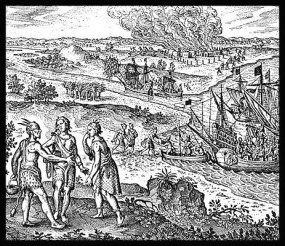First Peoples (The Earliest Americans)
Culture did not arrive in La Florida with the Spaniards. In fact when the Spaniards first arrived on the peninsula that they stationed La Florida upon, they would have found multiple cultures thriving throughout it and the Southeast. These cultures were those of the people indigenous to the land. Archaeological evidence points to people inhabiting Florida as far back as fourteen thousand years.
Though the Pre-Columbian population of Florida is hard to estimate, it may have, at one time, numbered as many as three million. The native people of Florida did not belong to one great group. Individuals would have practiced an allegiance to smaller, local chiefdoms. While alliances and confederacies arose between chiefdoms from time to time, chiefdoms were seldom organized into a single political unit. However, what did often connect these people was language. A variety of languages were spoken by different chiefdoms in the Southeast. Today, the native Southeastern people of the past are categorized by the languages they had in common with one another. Cultural traditions would have varied from chiefdom to chiefdom, with some common denominators. The indigenous cultures in the Southeast were semi-nomadic and semi-agricultural.
Contact with European peoples began in the early 1500s. Initial contacts would have been violent and tragic. The Portuguese were looking for slaves to work in the sugar plantations of the Caribbean and Brazil, while the Spanish wanted to conquer the Americas for themselves. Additionally, when the Europeans arrived they brought diseases that the Native Americans were not immune from. Microbes carried from Europe effectively depopulated huge areas of the Americas. Measles, mumps, smallpox, typhoid, typhus, diphtheria, and a host of other organisms took many lives. The spread of disease would have begun in Florida with these first contacts.
Within a few decades of European settlement in Florida, as much as 80% of Florida’s indigenous population was gone. Most of what we know about them is from the few notes and drawings the early explorers made and from the archeological evidence left behind.
The Pre-Columbian artifacts (tools and cultural relics) that archaeologists have found in Florida are almost exclusively of organic materials such as stone, wood, bone and clay. Some small ornamental pieces of copper and gold have been found, but there is no great evidence of metalworking. Pieces of metalworks excavated in Florida suggest that Southeastern tribes may have acquired these artifacts through trade or salvage of European shipwrecks as metalworking was not a part of Southeastern tribes’ way of life like other tribes further south in the Americas.

